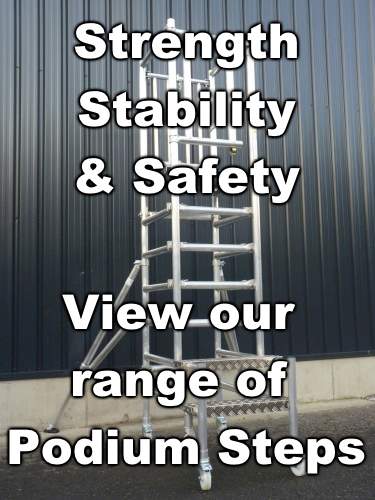Roof Ladders
- BPS Single Section Professional Roof LaddersRRP up to £279.99Our Unbeatable Prices
From
£199.99
Inc. VATlearn more - BPS 2 Section Professional Roof LaddersRRP up to £354.99Our Unbeatable Prices
From
£279.99
Inc. VATlearn more
Gaining access to a rooftop can be dangerous and requires a high quality, suitable ladder solution. Here at BPS our range of professional roof ladders are the ideal choice because they are made from aluminium, making them incredibly strong and secure for the climber whilst being lightweight and easy to manoeuvre. Also, they boast a range of other impressive features such as PVC coated support bearers, ensuring the ladder is easy to climb as well as preventing any damage to the roof tiles. Opting for a less secure design or a normal ladder which isn’t fixed to the top of the roof could lead to a serious injury.
Setting up a roof ladder safely
Typically, a leaning ladder will be used to help the roof ladder to be carried up onto the roof. The leaning ladder must be used following schedule 6 of the work at height regulations. With this in mind there are 4 main things to think about and check:
1) The ground or surface on which the leaning ladder is going to rest. It needs to be stable, firm, and strong enough to safely support the ladder when a load is added.
2) The ladder needs to be prevented from slipping by securing it at or near its top or bottom.
3) The ladder needs to be long enough to extend above the roof ladder by 3 rungs. This will provide a good handhold when getting onto the roof ladder.
4)The ladder should lean at an angle of 75 degrees to the ground.
A roof ladder is not too dissimilar from a normal ladder except it has two hooks attached at the end. The hooks allow the ladder to attach to the peak of a roof, making it secure. The climber can then easily and safely move up and down the roof whilst having a base to balance and complete work from. To set up your roof ladder securely and in the right position you should take full advantage of its design and use the wheels to allow you to push it up the roof. When the wheels reach the top of the roof ridge you can turn the ladder over and hook it safely onto the ridge of the roof. Once it is set up, there should be at least three rungs sat above the gutter as the ladder must be long enough for the job at hand.
Using the ladder safely
Before you start moving you must always make sure you have secure footing on the lowest rungs of the ladder. You should also always keep a firm grip on the ladder with both hands and avoid carrying too much weight as it could increase your chance of having a fall. Any tools and materials you need to carry should be kept secure on a tool belt for example. You should climb up and down the roof ladder by crawling and gripping the rungs not the stiles (sides) with your hands.
If there is bad weather on the day you are due to carry out roof work don’t try to continue with the job. Poor weather can affect your grip and balance on the roof as well as the ladder and you would be putting yourself in significant danger of having an accident. Also, be aware of any overhead power lines, as with our roof ladders most roof ladders are made from aluminium which is a good conductor of electricity. Not checking the safety of your surroundings could lead to an electric shock or other incidents.
A roof ladder must never be used as a bridge or a leaning ladder. They are designed for use on a sloping roof and therefore must not be used on flat roofs or very steeply pitched.
On what kind of roof is a roof ladder suitable to use?
The roof should have a roof pitched angle of between 25 and 45 degrees, don’t use a roof ladder outside of this range. The ladder must be the right length for the job, if too long it can overhang the roof edge by so much that it becomes unbalanced. If too short accessing the ladder will require stepping onto the roof itself which could increase the risk of damage to tiles and slipping off.
It’s important to remember that the roof must be capable of supporting the weight of the ladder and the user. Some sheet roofing such as polycarbonate and other lightweight roofing systems might not be suitable.
Wearing personal protective equipment
When carrying out work at height on a roof it's essential to wear the right clothes to keep you as safe as possible. This includes the following:
- Appropriate trousers - working on a roof means protecting your legs from any cuts, grazes, and splinters so it’s not a good idea to wear shorts.
- Protective footwear - steel toe caps (or a suitable equivalent) are needed to protect against any dropped objects. Also, midsole protection is required to prevent puncture by nails and other sharp materials.
- Safety helmet s- there are two reasons to wear a safety helmet for roof work. Firstly, it can help to protect you from anything that may fall off the roof, when climbing up or down or when on the ground. The second reason is to protect you in case of a fall.
- Safety glasses - these should always be worn in situations where material can possibly fly into the eyes. This includes all cases where cutting or sawing is needed.
- Knee pads- you should consider these to protect your knees from strain and damage, as a result of compression and wear on the joints from the roof work.
· Seasonal safety- think about both summer and winter working conditions when selecting your roof work clothing. In summer, it’s important to wear sun cream to protect you from sunburn and skin damage. In winter, warm clothing that still gives you freedom of movement should be worn, such as fleeces and jackets, hats, and gloves. Being cold can increase your chance of a fall as it numbs sensation which can cause a loss of grip as well as stumbling or tripping over.










